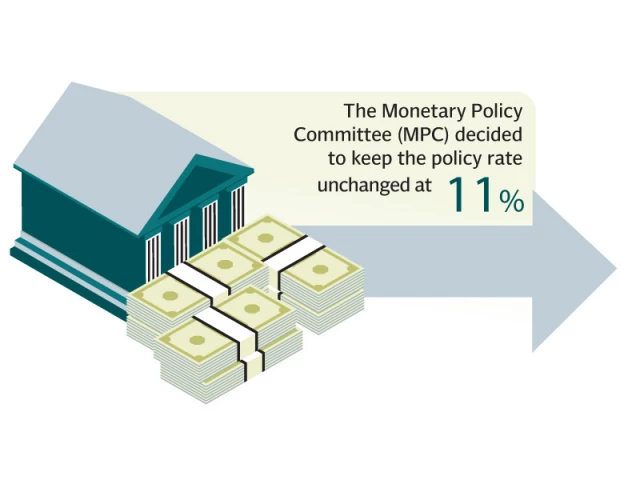SBP holds policy rate amid floods
MPC keeps rate unchanged at 11%; warns of food inflation, external pressure

The State Bank of Pakistan (SBP) on Monday decided to keep its benchmark policy rate unchanged at 11%, indicating that the country's near-term economic outlook has weakened due to the devastating floods that have disrupted crop production and supply chains.
While inflation has remained relatively moderate in recent months, the Monetary Policy Committee (MPC) cautioned that food inflation and external pressures could intensify in the coming months, posing fresh challenges for policymakers already juggling growth and stability concerns.
Although the business community has denounced the decision, it was largely in line with market expectations.
"In line with market expectations, the central bank has kept the rate unchanged at 11% in meeting held today," noted Topline Securites. Taurus Securities seconded the statement in its report.
The MPC observed that inflation eased to 3% in August from 4.1% in July, supported by a gradual decline in core inflation. Economic activity, measured through high-frequency indicators and large-scale manufacturing, had picked up momentum in the second half of FY25, but the floods have created a temporary yet significant supply shock, especially in agriculture, with likely spillover effects on manufacturing and services.
One of the most immediate challenges identified in the statement is the reversal of earlier optimism on growth and inflation. While Pakistan's economy had begun to recover from past shocks, the floods have inflicted damage on Kharif crops and disrupted logistics, weighing heavily on overall growth prospects. Real GDP growth for FY26 is now expected to hover around the lower end of the previously projected 3.254.25% range.
The floods are also expected to trigger a surge in food inflation, even as core inflation trends downward. Weekly price data already shows sharp increases in perishables and wheat, raising concern that inflation may breach the SBP's medium-term target range of 57% for much of FY26 before stabilising in FY27. Although a recent cut in electricity tariffs may ease some pressure, the near-term inflation outlook remains highly uncertain.
The external sector outlook also faces heightened risks. Pakistan's current account deficit stood at $254 million in July, driven by higher imports and weaker remittances. Flood-related crop losses are expected to widen the trade deficit, though improved market access to the United States could partly offset these pressures.
SBP's foreign exchange reserves remained stable at $14.3 billion as of September 5, but inflows remain crucial to keep the balance. The central bank projects reserves could rise to around $15.5 billion by December if planned official disbursements materialise. Despite these projections, the MPC admitted that the external sector remains fragile and vulnerable to both domestic disruptions and volatile global conditions.
On the fiscal side, the government achieved 14.1% year-on-year growth in tax revenues during JulyAugust 2025. The transfer of Rs2.4 trillion in SBP profit and higher petroleum levy collections are expected to generate a sizeable primary surplus in the first quarter of FY26. However, the MPC warned that floods could raise current expenditures while at the same time dampening revenue collection. Without continued reforms to broaden the tax base and restructure loss-making state-owned enterprises, fiscal buffers could quickly erode, limiting the government's ability to cushion future shocks or boost social and development spending.
Another area of concern lies in money and credit dynamics. Broad money growth slowed to 13.9% year-on-year by late August, mainly driven by deposits, while budgetary borrowing from banks declined after the transfer of SBP profits. Encouragingly, private sector credit accelerated to 14.1%, supported by rising borrowing for working capital, fixed investment, and consumer financing. However, the MPC warned that this momentum could face headwinds if flood-related disruptions dampen business confidence in the months ahead. Sustaining private credit growth while containing inflation and fiscal pressures will require continued coordination of monetary and fiscal policies.
While the MPC stressed that Pakistan is in a stronger position to withstand shocks compared to previous flood episodes, thanks to lower inflation, improved fiscal buffers, and relatively stable global commodity prices, it acknowledged several risks that could derail the outlook. These include flood-induced supply shocks, volatile international commodity prices, potential revenue shortfalls, uncertain remittance flows, and unanticipated adjustments in energy tariffs.
The decision to hold the policy rate at 11% underscores the SBP's balancing act: safeguarding price stability while supporting growth in the face of severe natural disruptions, according to PMC statement. The committee noted that Pakistan has built resilience over the past two years, but sustaining it will require discipline, structural reforms, and careful management of the flood's economic fallout.





















COMMENTS
Comments are moderated and generally will be posted if they are on-topic and not abusive.
For more information, please see our Comments FAQ